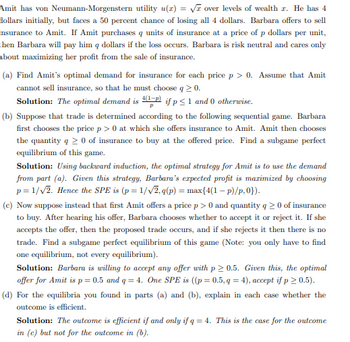
ENGR.ECONOMIC ANALYSIS
14th Edition
ISBN: 9780190931919
Author: NEWNAN
Publisher: Oxford University Press
expand_more
expand_more
format_list_bulleted
Question
PLEASE HOW TO THINK ABOUT IT AND SOLVE

Transcribed Image Text:Amit has von Neumann-Morgenstern utility u(x)=√ over levels of wealth r. He has 4
dollars initially, but faces a 50 percent chance of losing all 4 dollars. Barbara offers to sell
insurance to Amit. If Amit purchases q units of insurance at a price of p dollars per unit,
then Barbara will pay him q dollars if the loss occurs. Barbara is risk neutral and cares only
about maximizing her profit from the sale of insurance.
(a) Find Amit's optimal demand for insurance for each price p > 0. Assume that Amit
cannot sell insurance, so that he must choose q ≥ 0.
Solution: The optimal demand is 4(1-P) if p ≤ 1 and 0 otherwise.
P
(b) Suppose that trade is determined according to the following sequential game. Barbara
first chooses the price p > 0 at which she offers insurance to Amit. Amit then chooses
the quantity q ≥ 0 of insurance to buy at the offered price. Find a subgame perfect
equilibrium of this game.
Solution: Using backward induction, the optimal strategy for Amit is to use the demand
from part (a). Given this strategy, Barbara's expected profit is maximized by choosing
p=1/√2. Hence the SPE is (p=1/√2,q(p) = max{4(1-p)/p,0}).
(c) Now suppose instead that first Amit offers a price p>0 and quantity q≥ 0 of insurance
to buy. After hearing his offer, Barbara chooses whether to accept it or reject it. If she
accepts the offer, then the proposed trade occurs, and if she rejects it then there is no
trade. Find a subgame perfect equilibrium of this game (Note: you only have to find
one equilibrium, not every equilibrium).
Solution: Barbara is willing to accept any offer with p≥ 0.5. Given this, the optimal
offer for Amit is p = 0.5 and q = 4. One SPE is ((p = 0.5,q = 4), accept if p > 0.5).
(d) For the equilibria you found in parts (a) and (b), explain in each case hether the
outcome is efficient.
Solution: The outcome is efficient if and only if q = 4. This is the case for the outcome
in (c) but not for the outcome in (b).
Expert Solution
This question has been solved!
Explore an expertly crafted, step-by-step solution for a thorough understanding of key concepts.
Step 1: Define optimal demand and sub game perfect equilibrium
VIEW Step 2: A) Person A's optimal demand for insurance
VIEW Step 3: B) Interpret the sub game perfect equilibrium for the given scenario
VIEW Step 4: C) Interpret the sub game perfect equilibrium for the given scenario
VIEW Step 5: D) Interpret whether the outcome is efficient
VIEW Solution
VIEW Step by stepSolved in 6 steps with 13 images

Knowledge Booster
Learn more about
Need a deep-dive on the concept behind this application? Look no further. Learn more about this topic, economics and related others by exploring similar questions and additional content below.Similar questions
arrow_back_ios
arrow_forward_ios
Recommended textbooks for you

 Principles of Economics (12th Edition)EconomicsISBN:9780134078779Author:Karl E. Case, Ray C. Fair, Sharon E. OsterPublisher:PEARSON
Principles of Economics (12th Edition)EconomicsISBN:9780134078779Author:Karl E. Case, Ray C. Fair, Sharon E. OsterPublisher:PEARSON Engineering Economy (17th Edition)EconomicsISBN:9780134870069Author:William G. Sullivan, Elin M. Wicks, C. Patrick KoellingPublisher:PEARSON
Engineering Economy (17th Edition)EconomicsISBN:9780134870069Author:William G. Sullivan, Elin M. Wicks, C. Patrick KoellingPublisher:PEARSON Principles of Economics (MindTap Course List)EconomicsISBN:9781305585126Author:N. Gregory MankiwPublisher:Cengage Learning
Principles of Economics (MindTap Course List)EconomicsISBN:9781305585126Author:N. Gregory MankiwPublisher:Cengage Learning Managerial Economics: A Problem Solving ApproachEconomicsISBN:9781337106665Author:Luke M. Froeb, Brian T. McCann, Michael R. Ward, Mike ShorPublisher:Cengage Learning
Managerial Economics: A Problem Solving ApproachEconomicsISBN:9781337106665Author:Luke M. Froeb, Brian T. McCann, Michael R. Ward, Mike ShorPublisher:Cengage Learning Managerial Economics & Business Strategy (Mcgraw-...EconomicsISBN:9781259290619Author:Michael Baye, Jeff PrincePublisher:McGraw-Hill Education
Managerial Economics & Business Strategy (Mcgraw-...EconomicsISBN:9781259290619Author:Michael Baye, Jeff PrincePublisher:McGraw-Hill Education


Principles of Economics (12th Edition)
Economics
ISBN:9780134078779
Author:Karl E. Case, Ray C. Fair, Sharon E. Oster
Publisher:PEARSON

Engineering Economy (17th Edition)
Economics
ISBN:9780134870069
Author:William G. Sullivan, Elin M. Wicks, C. Patrick Koelling
Publisher:PEARSON

Principles of Economics (MindTap Course List)
Economics
ISBN:9781305585126
Author:N. Gregory Mankiw
Publisher:Cengage Learning

Managerial Economics: A Problem Solving Approach
Economics
ISBN:9781337106665
Author:Luke M. Froeb, Brian T. McCann, Michael R. Ward, Mike Shor
Publisher:Cengage Learning

Managerial Economics & Business Strategy (Mcgraw-...
Economics
ISBN:9781259290619
Author:Michael Baye, Jeff Prince
Publisher:McGraw-Hill Education